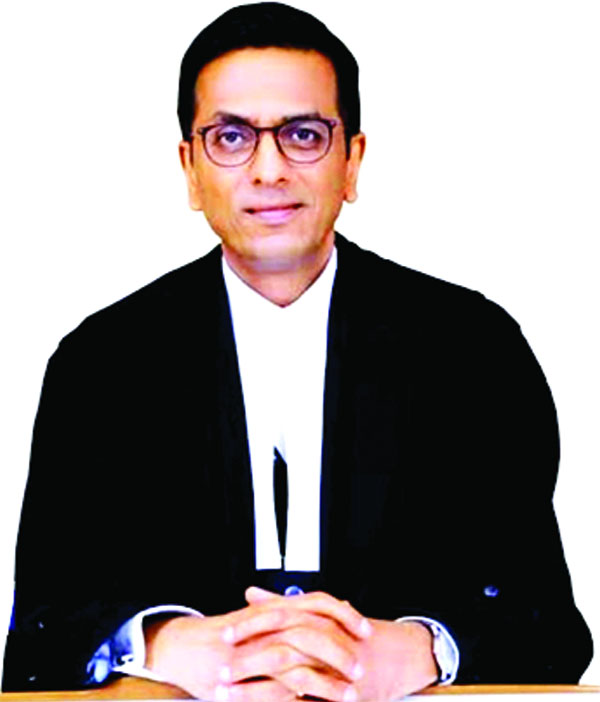DOGRA HERALD BUREAU
NEW DELHI, May 15
Chief Justice of India DY Chandrachud said on Wednesday the Supreme Court has heard over 7,50,000 cases via video-conferencing and more than 1,50,000 cases were filed online as technology has re-negotiated the relationship between law and enforcement agencies, including the judiciary.
Addressing the J20 Summit at Rio de Janeiro on ‘Digital transformation and the use of technology to enhance judicial efficiency’, the CJI referred to India’s achievements and said, “Virtual hearings have democratised access to the Supreme Court.”
J20 is a summit of the heads of supreme courts or the constitutional courts of G20 member states and is being organised by the Brazilian Federal Supreme Court in light of Brazil’s Presidency of G20 this year.
The CJI said the Indian Supreme Court’s Case Management System has been developed on Free and Open Source Software (FOSS), and is ”the largest case management system in the world”.
Justice Chandrachud also said that even after the pandemic, hybrid hearings continue to be a feature of Indian courts, and the virtual hearings have opened up the space for people who face difficulties in physically appearing before the courts.
”Over 7,50,000 cases have been heard over video-conferencing. The proceedings of important constitutional cases in the Supreme Court are live-streamed on its YouTube channel — bringing constitutional deliberations to the homes and hearts of all citizens. The Supreme Court of India today is almost entirely paperless, with digitised and optical character recognition-enabled paper-books,” he said.
”Technology has re-negotiated our relationship with the law and the institutions that enforce it,” Chandrachud said, adding, ”Judges are after all perhaps the only public functionaries who are perched on a raised platform, who punish for contempt and make important decisions about the lives of others in discrete private chambers, without the fear of electoral losses.” He said the top court was using software — SUVAS (Supreme Court Vidhik Anuvaad Software) — to translate judgments in 16 regional languages.
”Over 36,000 cases have thus far been translated. There is also live-streaming and YouTube recordings of important constitutional cases that provide the complete context. Easy access to the judgments of the Supreme Court is provided for through Digital SCR (Supreme Court Records), where over 30,000 old judgements are available for free,” the CJI said.
Observing that the judges are ”neither princes nor sovereigns who are above the explainability requirement”, he said the judiciary is the service provider and enabler of the rights-affirming societies.
Chandrachud said there are two crucial areas in which digitisation and technology can help the judiciary create better justice delivery mechanisms. The first is streamlining of the pre-decision processes and the other is the post-decision measures that improve access to and engagement with the decision itself.
”Indian courts’ tryst with information technology advancements began in 2007 with the e-Courts project — a country-wide project for improving judicial efficiency and creating citizen-centric justice delivery services. The front-desk experience of approaching courts has changed completely.
”We now have the facility of filing cases at the click of a button through our e-filing platform. Over 1,50,000 e-filings have been done so far just at the Supreme Court, with a consistent rise in the share of e-filings compared to physical filings,” he said.
The Supreme Court monitors judicial data of the entire country in real time by using the National Judicial Data Grid and iJuris — information sharing platforms for the district-level judiciary, the CJI said.
Dealing with the use of technology as ”post-decisional measures”, he said once a decision is delivered, it must be swiftly uploaded on the courts’ website for the parties to execute it or explore further remedies.
Speaking on the issue of ‘disinformation’ about the judicial hearings, the CJI said, ”We believe that sunshine is the best disinfectant, and that correct and accessible information is an antidote to disinformation.” ”In India, it is quite common for judges to engage with a bar and play the devil’s advocate, in order to extract their best response. However, this is sometimes mistaken as the opinion of the bench and misleading clips of the proceedings are circulated on the internet.
”Fortunately, we have a robust network of legal journalists who live-report the proceedings and help dispel disinformation,” Chandrachud added.
He also spoke on the digital divide and representational asymmetry between parties to dispute and low-connectivity locations.
Terming them as ”bottlenecks”, the CJI said, ”We must tackle. When we speak of judicial efficiency, we must look beyond the efficiency of the judge and think of a holistic judicial process. Efficiency lies not only in outcomes but in these processes which must ensure free and fair hearing.”



























